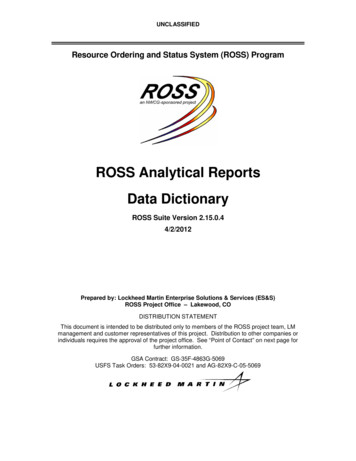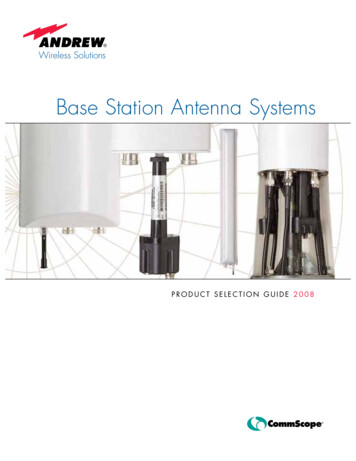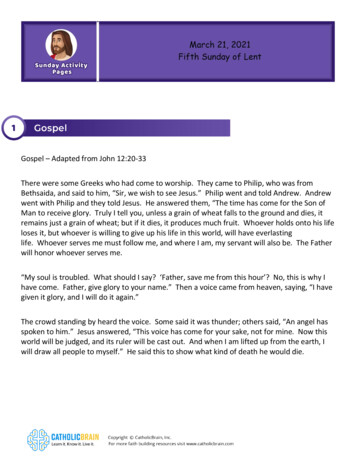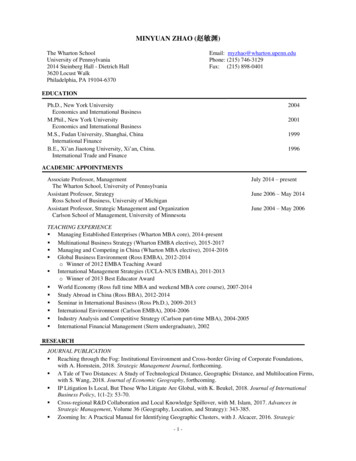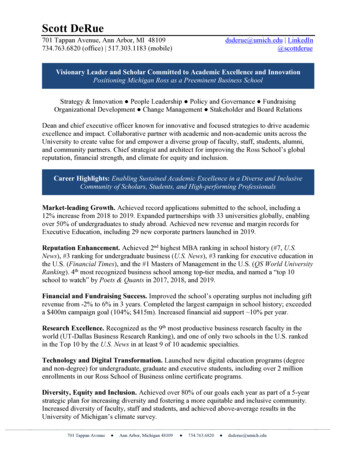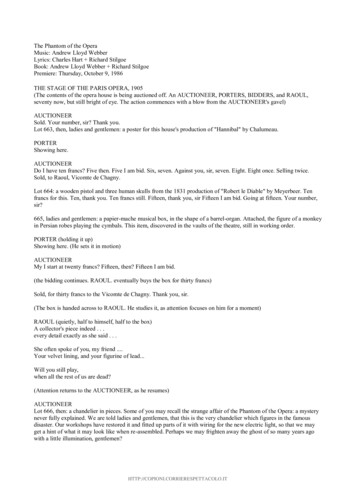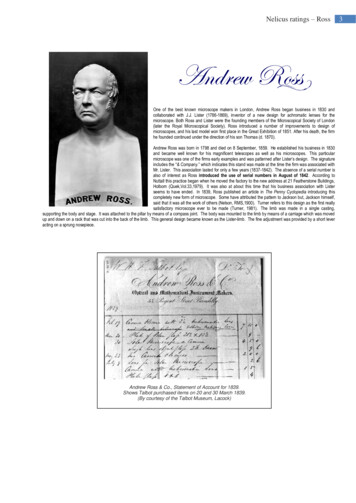
Transcription
Nelicus ratings – RossAndrew Ross One of the best known microscope makers in London, Andrew Ross began business in 1830 andcollaborated with J.J. Lister (1786-1869), inventor of a new design for achromatic lenses for themicroscope. Both Ross and Lister were the founding members of the Microscopical Society of London(later the Royal Microscopical Society). Ross introduced a number of improvements to design ofmicroscopes, and his last model won first place in the Great Exhibition of 1851. After his death, the firmhe founded continued under the direction of his son Thomas (d. 1870).Andrew Ross was born in 1798 and died on 8 September, 1859. He established his business in 1830and became well known for his magnificent telescopes as well as his microscopes. This particularmicroscope was one of the firms early examples and was patterned after Lister‟s design. The signatureincludes the “& Company.” which indicates this stand was made at the time the firm was associated withMr. Lister. This association lasted for only a few years (1837-1842). The absence of a serial number isalso of interest as Ross introduced the use of serial numbers in August of 1842. According toNuttall this practice began when he moved the factory to the new address at 21 Featherstone Buildings,Holborn (Quek,Vol.33,1979). It was also at about this time that his business association with Listerseems to have ended. In 1839, Ross published an article in The Penny Cyclopedia introducing thiscompletely new form of microscope. Some have attributed the pattern to Jackson but, Jackson himself,said that it was all the work of others (Nelson, RMS,1900). Turner refers to this design as the first reallysatisfactory microscope ever to be made (Turner, 1981). The limb was made in a single casting,supporting the body and stage. It was attached to the pillar by means of a compass joint. The body was mounted to the limb by means of a carriage which was movedup and down on a rack that was cut into the back of the limb. This general design became known as the Lister-limb. The fine adjustment was provided by a short leveracting on a sprung nosepiece.Andrew Ross & Co., Statement of Account for 1839.Shows Talbot purchased items on 20 and 30 March 1839.(By courtesy of the Talbot Museum, Lacock)3
Nelicus ratings – RossAndrew Ross Andrew Ross (1798-1859) was a renowned and successful scientific instrument maker in the 19th century. He was apprenticed to John Corless in the Joiners' Companyin 1813 and eventually became an optician, starting his own business in 1830. Ross had a strong personal interest in astronomy, however he quickly became wellknown for producing quality lenses and microscopes.From 1837 until 1841, Ross collaborated with Joseph Lister and continued to develop and influence microscope design and function. Lister is one of the most renownedpioneers in the field of microscopy, and his work with Ross helped put a spotlight on microscopes as an invaluable scientific tool in medical diagnosis and biologicalresearch. Ross and Lister were founding members of the Microscopical Society of London, which went on to become the Royal Microscopy Society. During these yearsthe company was renamed Andrew Ross & Co, until Lister left the business in 1841.Andrew Ross received high acclaim and many awards for his ingenious work with scientific instruments. In 1830 he received the Gold Isis Medal from the Society ofArts for his improved dividing astronomical and mathematical instruments and for his circular dividing engine. He received the same medal in 1836 for his improvementsin achromatic objectives of microscopes. In 1841 he received a silver medal from the Society for his invention of the spherometer. In 1851 Ross exhibited instruments inthe Great Exhibition, winning a medal for his microscope and his large equatorial telescope, which was highly admired by visitors.Ross was a highly esteemed member of the Photographic Society of London, who described him as a powerful genius and someone who excelled in perfection .The company was taken over by Thomas Ross, Andrew's son, in 1859, trading under the name Ross & Co.Thomas was also a member of the Photographic Society of London. Thomas focused much of the business into photographic lenses and became highly successful. Hislenses were so highly esteemed that they often fetched a higher price second hand than new. The Ross name also became well known for producing excellent qualitybinoculars, providing them to the British Military during World War One and World War Two.In 1948 the Ross company joined forces with camera manufactures Barnet Ensign to become Ross-Ensign, which then changed its name in 1954 to Barnet EnsignRoss. The company ceased to trade under the Ross name in 1975 when it was taken over by the company Avimo, who was later taken over by Thales Optics.The following is a list of dates and corresponding workshop addresses, found inscribed on Ross instruments in museum collections. (please note this list may not betotally accurate but can be used as a rough guide):Andrew Ross:1830-183915 St Johns Square, London.1837 – 1941Ross & Co:'Andw Ross & Co (with J.J. Lister)1839-184333 Regent St, Piccadilly.1843-184721 Featherstone Buildings, Clerkenwell, London1848-18562 Featherstone Buildings, Clerkenwell, London1859-onwardsLondon1880 – 1893112 New Bond StreetRoss/ LONDONCirca 1835Ross/ LONDONCirca 1839'Andw. Rofs / 33 regent St. /Piccadilly/ No 30'.No. 88 / Rofs/LondonROSS / London / 1967ROSS / London / 1967Andw Ross / LONDON / No169A Ross / LONDON / No 2014
Nelicus ratings – Ross1831Courtesy of Molecular ExpressionsSimple and compoundAndrew Ross fashioned the convertible, simple-compound microscope as a portable companion instrument to a fullsized brass compound microscope. Both were designed and commissioned in 1831 by William Valentine, a notedbotanist from Nottingham, England.The inspiration for the Valentine design may have come from Charles Gould, a British instrument maker who haddesigned a pocket version of the microscope that was portable enough for both the laboratory and routine botanicalfieldwork. In fact, many nineteenth-century craftsmen imitated the original concept that Gould described in an 1827publication. Nevertheless, the convertible simple-compound microscope is an early example of the finecraftsmanship of Ross, who created the instrument only a year after he established his telescope and microscopeworkshop in London.Illustrated above in its simple form, the Ross instrument features a lens holder that may carry either a single lens ora Wollaston doublet. When the holder is removed, however, a compound body tube fits the single pillar stand. Theinstrument also consists of a substage condenser tube that includes an adjustment for the condenser lens and alarge, concave mirror mounted on a brass gimbal that is attached to one leg of the Y-shaped microscope foot. Amassive mechanical stage is fixed to the pillar stand and is capable of moving at right angles through the use of apair of direct-acting screws. Later known as the Turrell mechanical stage, as a result of its description by WilliamTurrell in an 1832 publication, the innovative design for controlling x-y translational motion with one knob is the basisfor the modern mechanical stage. Flexible, but plagued with certain design flaws, several years later Ross createdan improved version of the convertible instrument intended for use during dissections.1831William Valentine, a plant anatomist in Nottingham, England, designed this microscope and commissioned it to be build byAndrew Ross in 1831. This is one of the earliest instruments build by Ross, who established his business the previous year,1830.An unusual feature of this microscope is the fine focus knob, that can be clearly seen under the base of the microscope. Theknob connects to a threaded rod that traverses the pillar or "foot" of the microscope and connects to the stage to effectmotion. This focusing technique is similar to that seen in two of George Adams' microscopes, the UniversalSingle and Universal Double microscopes, both of which were built almost 75 years earlier in 1746.Another interesting feature of this microscope is the rather long condenser tube that holds the substage condenser lens. Aconcave reflector mirror is positioned at the bottom of this tube in order to direct light onto the specimen. Because themicroscope was not fitted with an inclination mechanism, it was very uncomfortable to use for extended periods of time.1832Ross described a very similar instrument in 1831 (see A Ross - Trans.Soc.Arts,48,413), made in March of that year for Mr Valentine of Nottingham. The presentexample would have been made soon afterwards, and differs in a few particulars.This one has a heavy flat tripod foot, engraved with the signature, which does notfold. One arm carries the gimbal of the double-sided mirror, while at the centre is aCourtesy of Molecular Expressionspillar. The pillar contains both coarse and fine adjustments. The fine adjustmenthas a screw with fifty threads to the inch operating in a sprung bearing direct onthe sprung nut at the bottom of the triangular housing of the sprung coarse-focus triangular bar. This copious springingprevented lost motion in the adjustments - and still works very satisfactorily to this day. The head of the fine screw was large,set at the bottom of the pillar under the foot, and divided into 100 parts, thus allowing the height adjustments to be measuredto 1/5000". This may be the first use of a divided fine adjustment head for micrometry.Coarse focussing was carried out by a small milled head working a pinion in arack set into the rear of the inner triangular bar; this also is still perfectly smoothand positive in operation.The stage is plain, and supported by two long brackets. The top plate is movedby two screws at right angles, and has a small Varley multiple-plate insertoperated by a long lever with ivory handle below stage to give further mechanicalmotion of a very smooth and rapidly altered kind. Below stage screw one or otherillumination apparatus, both designed by Wollaston. One incorporates a mirror atthe bottom of a long tube surmounted by a focussing condenser, the other usesa similar condenser in a shorter tube which uses the main mirror.Courtesy of The Science Museum LondonInventory No.: 1921-217Valentine type?An Unusual Andrew Ross Brass Compound Monocular Microscope, English, mid 19th century, signed A Ross London, thetube supported by a racked column, focusing by knurled screw, on universal joint above column on tripod base, inmahogany case with two objectives and bench condenser, 32cm.(12 1/2in) highSold for 1.675 inclusive of Buyer's PremiumDate: october 2004Courtesy of BonhamsA.Ross, London5
Nelicus ratings – Ross1835A very different instrument from other Ross microscopes of its period. The heavy tripod foot, engraved with thesignature as above, has a clamping telescopic pillar at its centre, with a clamping ball and socket joint on top. Tothis is attached a collar, part of the main stage plate. From this descends a tube which carries a small sliding collarfor the gimbal of the small double-sided mirror. Above this is a stay for the pinion, and then another collar for an armto take accessories, and then the pinion housing itself, with large knobs on each side. Above this is the stage;below are large-headed screws holding an extension plate on each side, and a plain substage sleeve. The top plateis worked by two small rack and pinion heads set below the stage; it has a rotating sliding bar.At the top of the main collar a square-section bar rises, worked by the rack and pinion heads below stage level. Atthe top of the bar is an extraordinary device, designed to allow the body-tube arm to rotate through a clampable 90 while acting as a fine adjustment by raising and lowering the arm itself. This was done by a screw acting against acircular rod passing through the bar, pressed upwards by a strong spiral spring at its lower end. This mechanism isnow a little shaky, and it could never have been entirely satisfactory. The arm is short, and carries the body-tubewhich has sprung nosepiece (to absorb shocks to the objective while focusing), no drawtube, a Huygenianeyepiece, and an uncorrected objective.1835Courtesy of The Science Museum - LondonInventory No.: 1913-293This compound monocular microscope is the earliest Rossinstrument in the collection, and may be one of the four known tohave survived. The limb, which supports the body-tube and stage,is attached to the pillar by a ball-and-socket joint. The stagecarries a tubular column on its under surface, and the pillar sitson a flat tripod base. About 1835. Signed: Ross, London.Courtesy of University of TexasMedical Branch1832 ?Sold for 7.800 inclusive of Buyer's PremiumDate: December 2004Signed Ross London, with flat tripod base with sculpted end supporting a fixed pillar with rectangular clamping knoband ball-and-socket-joint to the end, right angled arm supporting the optical tube, black anodized brass square stagewith mechanical stage knob below, Wollatson condenser, contained within a mahogany case with accessoriescontained within a red leather case including lieberkuhn, stage forceps, condenser lens, live box and a stagemagnifier, and two eyepieces with covers and two objectives, also withtwo simple lenses for use as a simple microscope.The unusual ball-and-socket-joint at the top of the pillar, enabled theCourtesy of Sotheby sRoss / londonmicroscope to be titled and manoeuvred to almost any direction. It isbelieved that this type of ball-and-socket-joint derived from a design byPritchard‟s Ball and Socket Microscope.This particular microscope by Ross is extremely uncommon so–much-so that itsexistence was initially overlooked by Edward Nelson in his account of Ross microscopes. Its discovery was made in 1982by A. Morrison-Low and R.H.Nuttall who identified three examples: one in the Science Museum London, one in theUniversity of Edinburgh and one in the Moody Medical Library,Texas. Since then two others have emerged, one in aprivate collection and the example offered here. Nuttall has concluded that probably ten examples were made in total.1835A turned pillar stands on a flat base with three fold-out feet. The stage is attached to the top of the pillar by a compass joint.The stage plate rotates and a bracket to support specimens is held on the plate by spring clips. The cylindrical limb passesthough the stage. Two steadying struts attach the stage to the lower end of the limb where a socket holds the planoconcave mirror. Two milled heads at the rear of the limb raise a triangular sectioned bar that holds a vertical arm supportingthe body tube. The wooden case also contains four eyepieces, tow objectives in cans, and a stage bracket on pins.Courtesy of Museum History of Science OxfordInventory nº: 241836
Nelicus ratings – Ross1837Andrew Ross & Co.1838This instrument is very similar to that described by Ross in his article Microscope' in the Penny Cyclopaedia in 1839,but without the mechanical stage. The foot is flat and trilobular, engraved with the signature, and supporting a centralpillar carrying a compass joint. This supports a Lister limb, with the stage attached to its bottom end. From the stage atube descends, carrying the semi-gimbal of the double-sided mirror, and above it a nest of three turn-out stops. Thebase of the stage has a hole into which is fitted a sleeve carrying a small stage insert with double clip. The limb carriesa cradle to support the body, a device original to Ross (seeQ.J.M.S.,1, 219 (1853)). The cradle is worked by a pinionon its housing, into a rack attached to the rear of the limb. The body-tube is plain, without drawtube, and isengraved: To William Wright,/from the Head Masters/of University College School/T.H.K. & H.M./1838. A Huygenianeyepiece is fitted; there is no fine adjustment. Two achromatic objectives are included, both in boxesengraved: Andw.Ross & Co.,/Opticians/33 Regent St.,/Piccadilly. The one is a 1", the other 1/4". An alternative topplate, with sliding bar, is to hand for the stage.1839Some have attributed the pattern of bthis model to Jackson but,Jackson himself, said that it was all the work of others (Nelson,RMS,1900). Turner refers to this design as the first really satisfactorymicroscope ever to be made (Turner, 1981). The limb was made in asingle casting, supporting the body and stage. It was attached to thepillar by means of a compass joint. The body was mounted to the limbCourtesy of The Science Museum - Londonby means of a carriage which was moved up and down on a rack thatInventory No.: 1919-469was cut into the back of the limb. This general design became knownAndw.Ross & Co.,/Opticians/33 Regentas the Lister-limb. The fine adjustment was provided by a short leverSt.,/Piccadillyacting on a sprung nosepiece. Our present microscope is very muchlike the Penny Cyclopedia model and therefor is easily dated to that period.1838 - 1839"ANDRW. ROSS & CO OPTICIANS, 33 Regent St. Piccadilly".Tube: "REGISTERED No. 4380 JUNE 27th 1861"Originally a monocular microscope, the binocular body with asymmetrical, achromatic prism was a later addition. This brassinstrument is supported by a cylindrical pillar on a flat tripod foot. TheCourtesy of The Lundy AntiqueMicroscope Collectionmaker's name and address are inscribed on the foot. A compass jointOriginal Lister typeat the top of the pillar carries the shaped limb. The upper part of thelimb has a triangular cross section and rackwork on the rear face. The body tubes are held by brackets on a sleeve thatcan be racked up and down on the limb. The eyepieces have two lenses and push into the top of the tubes. The interocular distance is adjusted by a bar with milled knob at each end that extents the eyepiece fittings from the body. Finefocusing is adjusted by a mill-edged screw on the front of the lower part of the body. An internal thread on the nosetakes an objective. The mechanical stage has a plate mounted on a cylinder that fits the stage hole and allows theplate to rotate. A sliding bracket to support specimens has twopinholes and dovetails onto the stage plate. A post below the stagecarries the plano-concave mirror in a horseshoe mount on a slidingsleeve.Courtesy of Museum History of Science OxfordInventory nº: 42439ANDRW. ROSS & CO OPTICIANS, 33Regent St. PiccadillyThe accessories with this microscope are a bull's-eye lens on a stand,a spring state for glass phials, a condensing lens on a steel pin, stageforceps, four eyepieces and five objectives in cans, one with aLieberkuhn. Only one of the objectives fits the microscope.1838This brass instrument is supported by a cylindrical pillar on a flat tripod foot. The maker's name and address areinscribed on the foot. A compass joint at the top of the pillar carries the shaped limb. The upper part of the limb has atriangular cross section and rackwork on the rear face. The body tube is held on brackets on a sleeve that can beracked up and down on the limb. The eyepiece has two lenses and pushes into the top of the body. Fine focusing isachieved by a telescoping nosepiece. A mill-edged screw on the lower, front of the body pushes on a bracket that ishinged at the rear. This draws the nose from the body. A spring retracts the nose as the screw is released. An externalthread on the nose takes an objective. The mechanical stage has a plate mounted on a cylinder that fits the stage holeand allows the plate to rotate. A sliding bracket to support specimens has two pinholes and dovetails onto the stageplate. A post below the stage carries the plano-concave mirror in a horseshoe mount on a sliding sleeve.Courtesy of Museum History of Science OxfordInventory nº: 55549ANDRW. ROSS & CO OPTICIANS, 33Regent St. Piccadilly7
Nelicus ratings – Ross1840A large stand on a flat splayed horseshoe foot, engraved with the signature, with a central pillar surmounted by acompass joint. The joint is attached to a small box, from which descends a tube carrying the sleeve of the stalkedgimbal of the double-sided mirror. Above this is a further sleeve, carrying an arm with bush to take accessories. Thethick stage is attached to the box, with a substantial bracket below, with a dovetail slide for substage fittings in front.Within the stage is a fine focus adjustment, operated by a milled head on each side of it. These rotate a brass ring withserrated rim, which pushes against brass rods attached to the underside of the upper stage plate held in contact bysprings; rotation in one direction raises the stage, and vice versa. This is a rather complicated device for fine focussingused also by Powell at about the same time; needless to say, it was not long-lasting in application, although it workswell enough. There are rack and pinion movements to the upper plate, which has two holes for accessories.From out of the box winds a square-section bar controlled by a large knob; the rack is cut into the back of the bar itself.At the top of the bar is a socket for the pin of the body-tube arm, which can rotate through 90 . The arm rises to a longsleeve in which the body-tube can move for focussing; it is comparatively very narrow in diameter, lacks a drawtube,and has a Huygenian eyepiece. The objective is a 1/8" achromat (two doublets close together and one lens in front in asliding correction collar) as introduced by Ross about 1838.1840ANENGLISHMONOCULAURMICROSCOPEANDREW ROSS & CO, circa 1840 signed on the tripodCourtesy of The Science Museum - Londonfoot ANDW ROSS & CO OPTICIANS, 33 Regent St. Piccadilly; theInventory No.: 1921-213main body and accessories ?nickle-plated, 5 laquered brassobjectives in ?nickle-plated canisters, one later In. objectivesigned Ross London, substage accessories, bullseye condensot, fishplate; in wooden box with brass corners andfittings. 18¼ x 8¾ x 6¼in. (46 x 22.5 x 15cm.) The signature and street address give dates of 1837-41, the interiorfittings of the case suggest some alterations.Sold for 8.125 inclusive of Buyer's PremiumDate: October 2009Courtesy of Christie sANDW ROSS & CO OPTICIANS,Regent St. Piccadilly184033The low mahogany case is fitted, and has stoppings lined with blue plush. It contains an instrument resembling theJones "Most Improved" type of forty years before - quite a surprise for this maker at this time of his partnership with J JLister! The three folding feet, one engraved with the signature, make a flat tripod, which supports at its centre anelegantly tapered pillar terminating in a compass joint. To this is attached the square-section limb with a rack insertedinto its front. Low down this slides the collar of the stalked gimbal of the double-sided mirror, while along it runs thestage bracket driven by a pinion in its housing. The stage is a simple rectangle, with two lateral extensions drilled foraccessories, and a sprung double clip.At the top of the limb is attached in a slot the sliding body-tube arm.The tube screws into this; it has a drawtube and carries a two-lenseyepiece. There are four simple objectives, and another in alieberkuhn. In addition there are a hand forceps, stage forceps withextension arm, plane and dished glass discs for the stage aperture,livebox, and superstage condenser. A set of four four-place micacovered bone sliders and two four-place opaque sliders completesthe outfit.Courtesy of The Science Museum - LondonInventory No.: 1913-2931840This large instrument has a number of unusual features, not least the signatures of two makers: Ross and JamesSmith. The splayed-V foot is heavy and thick, and has a short pillar topped by a compass joint with wing-nut clamp.This carries a bracket with fine adjustment screw on its top, attached also to the tubular limb. From this descends atube carrying the sliding collar for the double-sided mirror gimbal, and strong double brackets for the stage. This ismechanical, with dovetailed plates worked by a vertical lever in a ball and socket, as publicised by White in 1844;there is a sliding rotating top plate. Below the stage is a screw-on rack and pinion focussing centring achromaticcondenser, the size of an objective, in a long tube with diaphragm opening at the bottom.The prismatic focussing bar has a rack attached to its rear, and wide knobs to control. The fine adjustment alreadymentioned is a screw which operates on a lever to raise and lower the entire coarse-focussing bar in its tube, quite anheroic idea. The bar has a high-rise body-tube arm at its top, interchangeable with another arm to carry simple lenses.The arm carries a sleeve in which the body-tube slides. There is a drawtube graduated to 6", and a Huygenianeyepiece. No objectives remain.Courtesy of The Science Museum - LondonInventory No.: 1928-863A Ross & Smith8
Nelicus ratings – Ross1840Simple and compound microscope. The Y-Shaped tripod foot of this instrument is 10 inches long and 8 inches wideat the front; the heel is hinged at 2 inches. The circular pillar is 4 inches high and 1-1/2 inches in diameter; it hascompass joint with a clamp at the lop. In this joint is a short, heavy arm, that carries the 8-inch circular limb, with aninner triangular bar. The stage plate is 5-1/4 x 4-3/4 inches with a mechanical stage above that has rectangularmotions controlled by two racks and pinions. Both pinions are fixed in a frame below the stage and are not parallel. Arevolving disc of diaphragms fits beneath the stage with a short cylindrical tube. There is a double mirror, 2-3/4inches in diameter at the lower end of the limb on a sliding sleeve, and immediately above is another sleeve with anangle arm for a screw-in condenser, polarizer or dark well. For use as a simple microscope, the entire arm may beremoved and another substituted.1841This rather elegant instrument is a development of the 1839design (see 1919-469) with its cradle for the body-tube; the cradlehas been abandoned and the rack is now attached to the body,Courtesy of The Billings Microscopealbeit on short brackets.CollectionsThe circular base is weighted with lead, and supports a shortInventory No.: 49091 – 60 – 4713 - 203Andw. Ross & Co / Opticians/33 Regentrotatable pillar topped by a compass joint. To this is attached theSt.,/Piccadilly.No 50Jackson-type limb, clamped for inclination by a large knob. Thebottom of the limb carries the stage, below which is a thick rodwith a tube sliding on it; this carries the gimbal of the double-sidedmirror. The stage is quite plain, with sleeves above and below; that above carries a rotatable and sliding top plateequipped with two clips. This is a very workable stage, allowing smooth positioning of a slide.Above stage level the limb curves below a long upright with attached sprung angles to contain the sliding bar fittedwith a rack; the pinion works in an attached housing. The body-tube, engraved with the signature, has a nosepiecefine adjustment, but no drawtube.Four Huygenian eyepieces are to hand. One is plain and of lower power, the others are all of power B, and containvarious devices. The one has two curved pointers, one worked by a small lever, the other by a screw to provideprecise positioning; this is an original Mathew caliper eyepiece. Asecond has two straight pointers worked by external sectors. Thethird has four internal straight leaves worked by external sectors, soas to allow any part of the field to be shown with the rest blackened.The objective is in a box signed: 1/4in/Andw.Ross &Co.,/Opticians/33 Regent St.,/Piccadilly.Courtesy of The Science Museum - LondonInventory No.: 1921-216Andw.Ross & Co.,/Opticians/33 RegentSt.,/Piccadilly.No 501841The microscope has a circular weighted base, a short pillar withrotating bearing, and a Lister-limb with mechanical stage with rotatingupper plate and substage wheel of three stops. There are twocontemporary objectives, and three eyepieces. Accessories include alieberkuhn, bull's eye condenser and stage forceps. It came in a fittedmahogany case (not shown). It is signed on the body tube: 'Andw. Rofs/ 33 Regent St. / Piccadilly / No 30.'Andrew Ross's partnership ceased at some point in 1841.Courtesy of National Museums ScotlandSubsequently, he began numbering his instruments: no 33 is in theAndw. Rofs / 33 Regent St. / Piccadilly /collection of the Royal Microscopical Society, and is very similar to thisNo 30example. It is also similar to the design illustrated by Ross in the articlehe wrote on the microscope for the Penny Cyclopaedia in 1839. In 1843, he introduced a Y-shaped foot, with bar-limb,which subsequently became known as the 'Ross model' microscope.1841The circular base is lead weighted for stability, and the short pillar ends with a bearing that allows rotation so as to placethe weight in the best position according to the inclination of the limb. The limb is held by a compass joint with aclamping screw. Rackwork moves a dovetailed slide to which the body-tube is fixed by two cradles. Fine focusing is by ashort lever on the nosepiece. The stage is a mechanical one, with an upper plate that rotates and slides. Below is aCourtesy of Royal Microscopical SocietyAndw Ross, Optician / 33 Regent Stthree-aperture rotating disc. The mirror is plano-concave, and is fixed to the lower part of the limb. The eyepiece isPiccadilly. /Nº 33Huygenian, and the unsigned objective is in a can engraved: 1/4 In. The lid of the can is signed in the same way as themicroscope.This microscope was described briefly and illustrated in JRMS 1899) 214 15. It is similar in many ways to the one illustrated by Ross in the article he wrote on themicroscope for the Penny Cyclopaedia (1839). Ross introduced the Y-shaped foot for which he is famous in 1843, the Society acquiring one of the first. This wasexchanged for an up-to-date model by Thomas Ross in 1861.The microscope with serial No 73 is in the Wellcome Museum at the Science Museum, London and this i
totally accurate but can be used as a rough guide): Andrew Ross: 1830-1839 15 St Johns Square, London. 1837 – 1941 'Andw Ross & Co (with J.J. Lister) 1839-1843 33 Regent St, Piccadilly. 1843-1847 21 Featherstone Buildings, Clerkenwell, London 1848-1856 2 Featherstone Buildings, Clerkenwell, London
